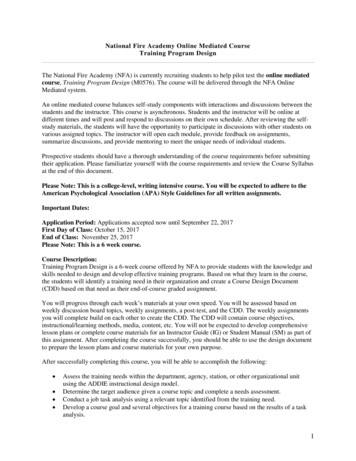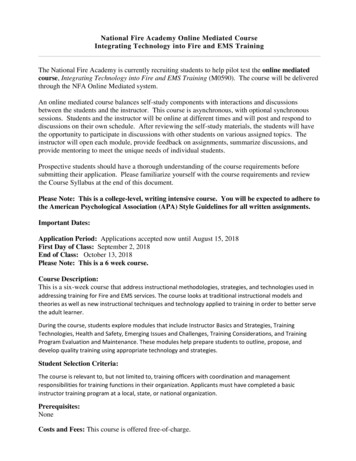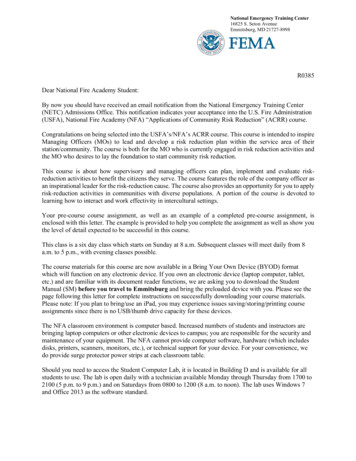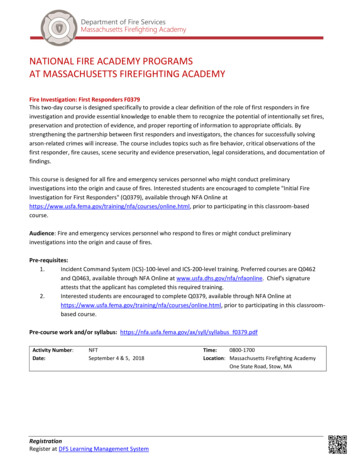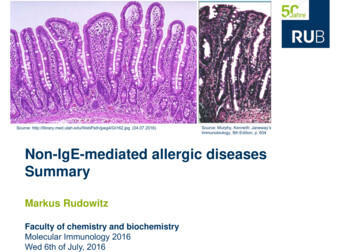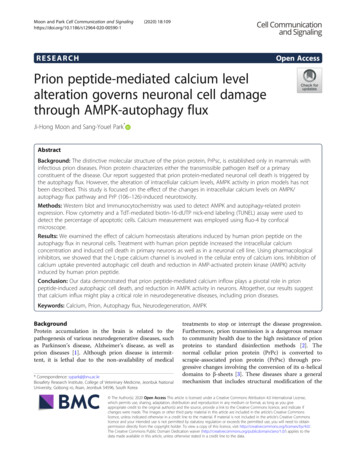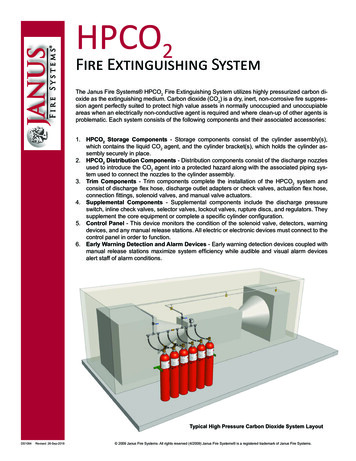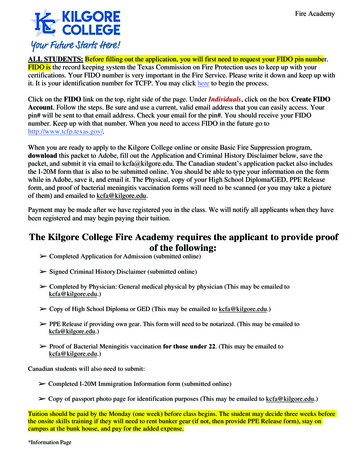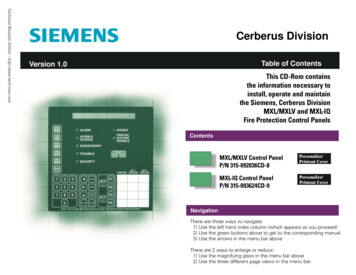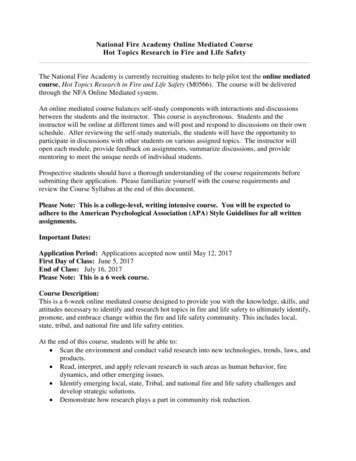
Transcription
National Fire Academy Online Mediated CourseHot Topics Research in Fire and Life SafetyThe National Fire Academy is currently recruiting students to help pilot test the online mediatedcourse, Hot Topics Research in Fire and Life Safety (M0566). The course will be deliveredthrough the NFA Online Mediated system.An online mediated course balances self-study components with interactions and discussionsbetween the students and the instructor. This course is asynchronous. Students and theinstructor will be online at different times and will post and respond to discussions on their ownschedule. After reviewing the self-study materials, the students will have the opportunity toparticipate in discussions with other students on various assigned topics. The instructor willopen each module, provide feedback on assignments, summarize discussions, and providementoring to meet the unique needs of individual students.Prospective students should have a thorough understanding of the course requirements beforesubmitting their application. Please familiarize yourself with the course requirements andreview the Course Syllabus at the end of this document.Please Note: This is a college-level, writing intensive course. You will be expected toadhere to the American Psychological Association (APA) Style Guidelines for all writtenassignments.Important Dates:Application Period: Applications accepted now until May 12, 2017First Day of Class: June 5, 2017End of Class: July 16, 2017Please Note: This is a 6 week course.Course Description:This is a 6-week online mediated course designed to provide you with the knowledge, skills, andattitudes necessary to identify and research hot topics in fire and life safety to ultimately identify,promote, and embrace change within the fire and life safety community. This includes local,state, tribal, and national fire and life safety entities.At the end of this course, students will be able to: Scan the environment and conduct valid research into new technologies, trends, laws, andproducts. Read, interpret, and apply relevant research in such areas as human behavior, firedynamics, and other emerging issues. Identify emerging local, state, Tribal, and national fire and life safety challenges anddevelop strategic solutions. Demonstrate how research plays a part in community risk reduction.
Student Selection Criteria:The primary audience for this course is any person responsible for programs within the fire andlife safety community. The primary audience typically includes fire and life safety professionalsand those working within the community, or allied professionals working in related fields.When starting the course, you should identify your specific role and indicate yourresponsibilities within the organization.Prerequisites:Designing an Applied Research Proposal (Q0171)Data Gathering Instruments to Support Applied Research Projects (Q0170)Note: These courses may be accessed online.htmlYou will need to create an account in NFA Online Self Study to complete these two prerequisitecourses. Registration and course access is free.Costs and Fees: This course is offered free-of-charge.How to Apply:Students must complete the General Admission Application ( FEMA Form 119-25-1) availableon the USFA website at: apply.htmlCompleted applications should be submitted by May 12, 2017 to:NETC Admissions Office16825 S. Seton AvenueEmmitsburg, MD 21727Completed applications can also be faxed to the NETC Admissions Office at 301-447-1441.
M0566 – Hot Topics Research in Fire and Life SafetyOnline Mediated Course SyllabusM0566 – Hot Topics Research in Fireand Life Safety Version: First Edition,First Printing, May 2017 Quarter:ACE Credit: PendingIACET Continuing Education Units:Length of Course: 6 WeeksPrerequisites:Designing an Applied Research Project Proposal (Q0171)Data Gathering Instruments to Support Applied Research Projects (Q0170)Curriculum: Fire Prevention: TechnicalTraining Specialist: Woody StrattonWoodrow.stratton@fema.dhs.gov
Course DescriptionM0566 – Hot Topics Research in Fire and Life Safety is a 6-week mediated online coursedesigned to provide you with the knowledge, skills, and attitudes necessary to identify andresearch hot topics in fire and life safety to ultimately identify, promote, and embrace changewithin the fire and life safety community. This includes local, state, tribal, and national fire andlife safety entities.Course ExpectationsFirst and foremost – have fun and participate. The more you participate, the more you learn.This course is designed to challenge you. This course will likely take more time than you mightexpect when you signed up for it, especially if you have not taken an online college-level courserecently. Expect to log in a minimum of 2-3 times per week and spend 10 hours per weekreading, researching, and writing your assignments.This cannot be stressed enough: To pass this course you must have a minimum grade of 70percent or higher and participate in each course discussion thread, etc. If you do not participateat all – or stop participating – your National Fire Academy transcript will reflect a “failing”grade. Please refer to the policy section for more details.Primary AudienceThe primary audience for this course is any person responsible for programs involved within thefire and life safety community. The primary audience typically includes fire and life safetyprofessionals and those working within the community, or allied professionals working in relatedfields.Course Scope (Goal)The goal of the course is to guide you through conducting solid research within the fire and lifesafety services field; evaluate and synthesize the data; and identify, promote, and embracechange within the fire and life safety community.Course ObjectivesAt the end of the course, you should be able to: Scan the environment and conduct valid research into new technologies, trends, laws,and products.Read, interpret, and apply relevant research in such areas as human behavior, firedynamics, and other emerging issues.Identify emerging local, state, Tribal, and national fire and life safety challenges anddevelop strategic solutions.Demonstrate how research plays a part in community risk reduction.
Course ContentIntroductionIcebreaking Discussion Board ActivityWhen starting the course, you should identify your specific role and indicate your responsibilitieswithin the organization.In 125-200 words, introduce yourself by providing: Your current role and experience in that role Your experience with fire and life safety in general Your organization What issue or issues do you believe will affect your community’s fire and life safetyservices over the next 3-5 years?For this discussion, you will need to respond to at least two other students. Discuss how theirrole or experience is similar to your own.Week 1: Identifying an IssueObjectivesTerminal ObjectiveScan the environment to identify an issue that affects your community or organizationEnabling ObjectivesYou will be able to: Identify community risk reduction issues needing researchIdentify your target audienceIdentify potential research sourcesReadings / ResourcesBasic vs. applied research (2016)Firefighter code of ethics. Retrieved fromhttps://www.usfa.fema.gov/downloads/pdf/code of ethics.pdfResearch flowchart (2016)United States Fire Administration. (2015). Research steps – Getting started: The researchprocess. Retrieved from http://usfa.libguides.com/research
ActivitiesDiscussionsGenerally, the initial post will be 175-300 words, and the follow-up responses 125-200 words.There are no “correct” answers to many of these discussion questions. The purpose behind thediscussion questions is to have your explore and evaluate your topic areas as well as interactwith and gain insight from other students in the class. As a result, you will need to respond to atleast two (2) other students.Discussion 1.1: Topic Area DiscussionThe purpose behind the discussion questions is to have you explore and evaluate your topicareas as well as interact with and gain insight from other students in the class. As a result, youwill need to respond to at least two (2) other students.Answer the following questions regarding your selected topic area:1.2.3.4.What is your topic area?Why did you select this topic area?Who is your target audience?How do the needs and requirements of your target audience fit into the framing of thetopic?In responding to other students, relate your experience and offer any suggestions on the topicarea (resources that you’ve found useful).The initial response for Discussion 1.1 is due on Thursday. As a course requirement,responses to a minimum of two other students’ discussion board posts are due on Saturday.AssignmentsAssignment 1.1: Topic Area Selection(Length between 500 - 750 words)Identify the topic and why that topic is important in the field of fire and life safety. How have yourefined this based on the previous discussion (Discussion 1.1)? Also, explain the following: What gave you this idea?How does it apply to your community?What resources do you intend to use?What challenges do you expect to encounter in undertaking this project and how do youplan to overcome those challenges?Who is the target audience for your topic?What are your plans for obtaining data?
Week 2: Identifying Resources and CollectingInitial DataObjectivesTerminal ObjectiveConduct valid research into new technologies, trends, laws, and products.Enabling ObjectivesYou will be able to: Identify important contextual issues that impact and influence community risk reductionissuesFrame the topic to be researchedLocate evidence-based resourcesDifferentiate between concepts and issuesDifferentiate among scholarly sources, trade journal sources, and popular periodicalsourcesReadings / ResourcesConcept vs. issue (2016)Contextual issues (2016)National Emergency Training Center Library. Designing your research strategy.Search engines, online informational databases, and search tactics (2016)Searching vs. Research (2016)United States Fire Administration. (2015). Scholarly articles: Overview. Retrieved fromhttp://usfa.libguides.com/scholarlyUnited States Fire Administration. (2015). Expanding, narrowing, excluding, and refining yourresults. Retrieved from http://usfa.libguides.com/research/tipsWhat is the question? (2013)ActivitiesDiscussionsDiscussion 2.1: What is the Question?The purpose behind this discussion is to have you explore and evaluate issues related toanalysis as well as interact with and gain insight from other students in the class. As a result,you will need to respond to at least two (2) other students.Review contextual issues and read “What is the question?” What potential pitfalls might you
encounter if you do not perform the analysis?In responding to other students, provide any experiences you may have encountered regardingthe stated pitfalls. Are there any additional contextual issues that should be considered?The initial response for Discussion 2.1 is due on Thursday. As a course requirement, responsesto a minimum of two (2) other students’ discussion board posts are due on Saturday.
Discussion 2.2: SourcesThe purpose behind this discussion is to have you explore the research process as well asinteract with and gain insight from other students in the class. As a result, you will need torespond to at least two (2) other students.State your topic and your audience. When conducting research on your topic, what sources didyou find the most helpful and why? Provide an example.In responding to other students, suggest additional resource those people might find helpful.Why do you think these resources would help?The initial responses for Discussion 2.2 are due on Thursday. As a course requirement,responses to a minimum of two (2) other students’ discussion board posts are due on Saturday.AssignmentsAssignment 2.1: Concept vs. Issue Self-testOnce you have reviewed the Concept vs. Issue information, complete the self-test bycompleting the quiz.StatementConcept orIssueFire modeling is “junk science” and doesn’t reflect the reality of firebehavior in a compartment.There are too many variables in fire dynamics to accurately predictthe effect of fire sprinkler systems in storage occupancies.Smoke alarms in one- and two-family dwellings are adequate inproviding early notification and prompt evacuation.Providing education to alter human attitudes and behaviors aboutfire.Juvenile firesetting is an innate, not learned, behavior.Fire safety education is not delivered equitably to all citizens.There is no such thing as an accidental fire.Enforcement of building and fire safety codes by pursuing violationsto assure compliance.Politicians are more concerned about community economic growththan public safety.Code enforcement personnel are not adequately trained to properlyinterpret and apply building and fire codes.Electronic performance interventions to solve just-in-time trainingneeds within departments.Not all digital training platforms are interoperable.Assignment 2.2: Source List(Length between 500 - 750 words)Find a minimum of five sources. Your list of sources must include at least one scholarly source,one trade journal source, and one popular periodical source. Identify the type of source for eachsource in your list. For each source, discuss the reliability of the source and how you intend touse it (e.g., supporting evidence, differing point of view, etc.)
Week 3: Research Design PlanObjectivesTerminal ObjectiveDevelop a research design plan.Enabling ObjectivesYou will be able to: Discuss how motivation affects the analysis and collection of dataIdentify research design plan componentsReadings / ResourcesAmbrust, C., Grant, P., & May, D. (2012). An examination of fire safety perceptions andbehaviors among students at a regional Midwestern university. International Fire ServiceJournal of Leadership and Management, 6, 33-41. Retrieved -edition-pdfs/IFSJLM Vol6.pdf.Marsar, S. (2013). The officer’s role in safe apparatus driving. Firefighter Nation. Retrieved s-driving.Research Plan. (2016).Required VideoBoston Globe. (2015). Firefighters recall colleagues who died from occupational cancer. [Videofile]. Retrieved from https://www.youtube.com/watch?v hOvBypsaHog.ActivitiesDiscussionDiscussion 3.1: MotivationThe purpose behind this discussion is to have you consider how motivation can affect sourcesused for research and the final product as well as interact with and gain insight from otherstudents in the class. As a result you will need to respond to at least two (2) other students.Watch the Boston Globe video.1. What is the motivation for producing the video? (What was the problem presented in thefirst place? Why is the problem important?)2. Several different groups (union, family members, etc.) are represented throughout thevideo. Choose at least one group. What is that group’s motivation to appear in thevideo?3. Consider the topic area you have selected for your research paper. What is yourmotivation for discussing this topic?4. If you were to produce a video for your topic area, what groups do you think would
participate? Why?5. What groups would not participate and why?In responding to other students, discuss whether there are other groups that mightparticipate in his/her video. Why would they be motivated to appear?The initial response for Discussion 3.1 is due on Thursday. As a course requirement, responsesto a minimum of two other students’ discussion board posts are due on SaturdayAssignmentsAssignment 3.1: Identifying Research Design Plan Components(Length between 500 - 750 words)1. Read the following two articles: An examination of fire safety perceptions and behaviors among students at aregional Midwestern university The officer’s role in safe apparatus driving2. For each article, identify the Assumptions, Inferences, Concepts, and Point of View.3. Compare your findings for the two articles. How are the two articles different regardingthe Assumptions, Inferences, Concepts, and Points of View?Assignment 3.2: Research Design Plan(Length between 500 - 750 words)Complete the Research Design Plan for your topic. Include the purpose, question, informationgathered, assumptions, and inferences/interpretations/conclusions, concepts, and point of view.
Week 4: Collecting Additional/Supporting Data, AnalyzingData, Interpreting Findings, and Stating ConclusionsObjectivesTerminal Objectives Develop conclusions that support solutionsEnabling ObjectivesYou will be able to: Focus research through modified keywords and/or key phrasesApply Evaluating Thinking criteria to determine the validity of sourcesApply Quality in Information criteria to determine the validity of sourcesDevelop strategic solutions.Readings / ResourcesCommon research tools – Other sources; Common methodologies (2016)Evaluate thinking (2016)Evaluating quality in information (2016)Validity assessment (2016)ActivitiesDiscussionDiscussion 4.1: KeywordsThe purpose behind this discussion is to identify keywords that are relevant to your topic ofinterest and consider how to effectively arrange words to garner the best research results aswell as interact with and gain insight from other students in the class. As a result, you will needto respond to at least two (2) other students.1. Identify any unique keywords or phrases specific to your topic that you have notsearched before.2. What were the results?3. How has this affected your research?(For example, a search for the term “campus fire alarms” may be further narrowed by searchingfor “reducing nuisance alarms on campus,” and further narrowed by searching for “reducing
nuisance alarms from microwave ovens on campus.” The effect might be dramatic.)In responding to other students, are there any additional keywords you would recommendsearching based on your experience? Why would those words be effective keywords?The initial response for Activity 4.1 is due on Thursday. As a course requirement, responses toa minimum of two other students’ discussion board posts are due on SaturdayAssignmentsAssignment 4.1: Evaluating Thinking and Quality in Information(Length between 500 - 750 words)Choose your most significant source (the one you intend to use the most in your paper) andevaluate the content based on the six Evaluating Thinking criteria: Clarity, Accuracy, Relevance,Depth, Logical, and Breadth. Using examples, explain how this source meets the criteria.Next, evaluate that same source for Quality in Information: Accuracy, Scope of Coverage,Objectivity, Timeliness, Authority, and Verifiability. Explain how your source meets at least four(4) of these criteria.Assignment 4.2: Develop Your ConclusionIn 500-750 words, state your conclusions and explain how you arrived at your conclusion byincorporating the answers to the questions listed below: What is the issue?Does data support that the issue exists?Whom does this issue impact?How are they impacted?Based on this information, what is the conclusion?What action(s) should be taken to address this issue?How do the solutions (actions) address the issue?
Week 5: WritingObjectivesTerminal ObjectiveDevelop a draft research paper using the report format providedEnabling ObjectivesYou will be able to: Identify abstract components.Develop citations using APA format.Readings / ResourcesAbstract. (2016).Billings, D. (2014). EMS under fire: Developing an active shooter incident response plan forthe Manchester fire – rescue – EMS department. Retrieved Johnson, L. (2013). Building a community injury profile: The first step toward a risk reductionprogram for the city of Dallas. Retri
The National Fire Academy is currently recruiting students to help pilot test the online mediated course, Hot Topics Research in Fire and Life Safety (M0566). The course will be delivered through the NFA Online Mediated system. A
